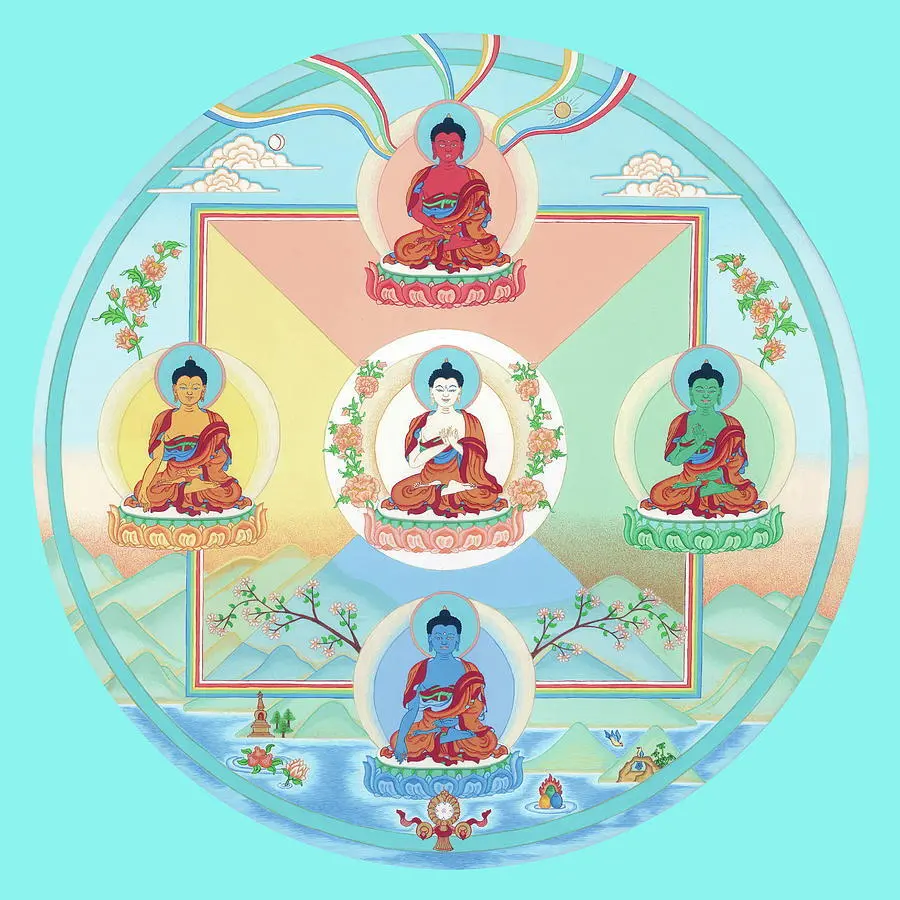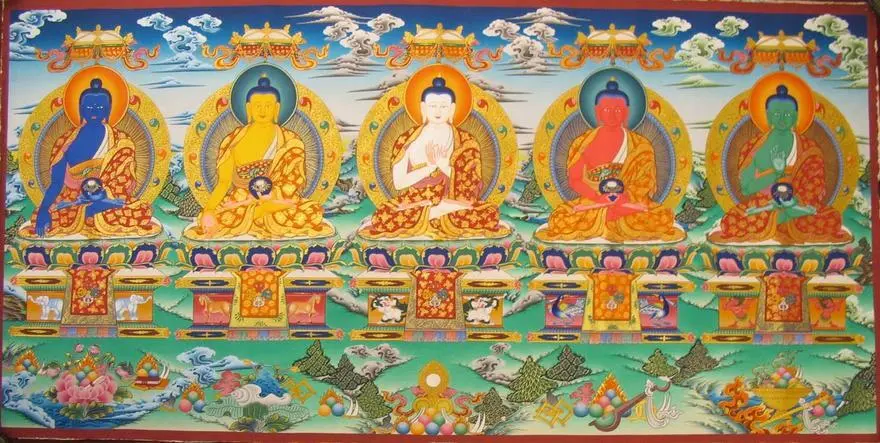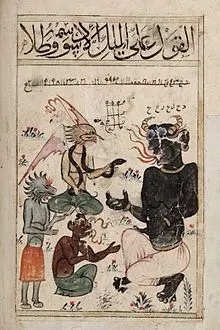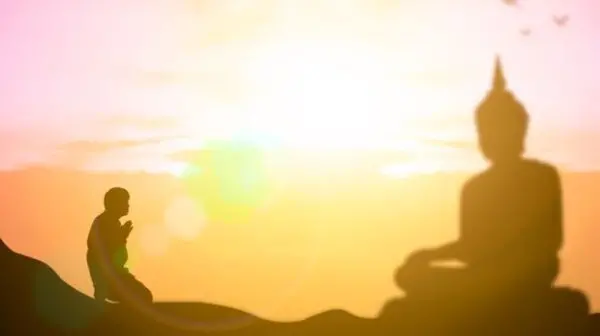 Five Dhyani Buddhas and Their Mandala
Five Dhyani Buddhas and Their Mandala
To the initiate, the mandala of the Five Dhyani Buddhas is at once a cosmic diagram of the world and of himself. It is a tool for spiritual growth and mystical experience—a map to enlightenment alive with divine possibilities.
The Five Dhyani Buddhas: Guides to Spiritual Transformation
The names of the Five Dhyani Buddhas are Vairochana, Akshobhya, Ratnasambhava, Amitabha and Amogasiddhi. Tibetan Buddhists believe that the Adi-Buddha, the primordial and highest being, created the Dhyani Buddhas by his meditative powers.
The Five Dhyani Buddhas are celestial Buddhas whom we visualize during meditation.
The word Dhyani is derived from the Sanskrit dhyana, meaning “meditation.” The Dhyani Buddhas are also called Jinas (“Victors” or “Conquerors”). They are transcendent beings who symbolize universal divine principles or forces. The Dhyani Buddhas represent various aspects of the enlightened consciousness and are great healers of the mind and soul. They are our guides to spiritual transformation.
Traditionally, each Dhyani Buddha is associated with certain attributes and symbols. Each one embodies one of the five wisdoms, which antidote the five deadly poisons that are of ultimate danger to man’s spiritual progress and keep him tied to worldly existence. Buddhists teach that the Dhyani Buddhas are able to transmute the five poisons into their transcendent wisdoms. The Tibetan Book of the Dead recommends that the devotee meditate on the Dhyani Buddhas so that their wisdoms will replace the negative forces he has allowed to take hold within.
Each Buddha rules over one of the directions of space and one of the cosmic realms of ether, water, earth, fire and air. The Dhyani Buddhas also personify the five skandhas, components that make up cosmic existence as well as human personality. These components are consciousness, form, feeling, perception and volition.
In addition, each Dhyani Buddha is associated with a specific color, mudra (hand gesture), symbolic animal that supports his throne, sacred symbol and bija (seed syllable). The bija represents the essence of the Dhyani Buddha. You can use it with the sacred syllable Om and the Buddha’s name to create a mantra. A mantra is defined as a series of mystic syllables that have an esoteric meaning. In Hinduism and Buddhism, disciples recite mantras to evoke the power and presence of a divine being. In some traditions, devotees use mantras in meditation to help them become one with the deity they are invoking.
“By repeating the mantra and assuming the mudra of any Buddha,” writes Buddhist monk and teacher Sangharakshita, “one can not only place oneself in correspondence or alignment with the particular order of reality which he personifies but also be infused with its transcendental power.”

Akshobhya Buddha: “Immovable One”
Akshobhya was a monk who vowed never to feel anger or disgust toward another being. He was immovable in keeping this vow. After striving for a long period, he became a Buddha. Akshobhya is a heavenly Buddha who reigns over the Eastern paradise, Abhirati. Those who fulfill Akshobhya’s vow are reborn in Abhirati and cannot fall back into lower states of consciousness. It’s important to note that the directional ‘paradises’ are understood to be a state of mind, not physical places.
Depictions of Akshobhya
In Buddhist iconography, Akshobhya is usually blue though sometimes gold. He is most often pictured touching the earth with his right hand. This is the earth-touching mudra, which is the gesture used by the historical Buddha when he asked the earth to bear witness to his enlightenment. In his left hand, Akshobhya holds a vajra, the symbol of shunyata — an absolute reality that is all things and beings, unmanifested. Akshobhya is also associated with the fifth skandha, consciousness. In Buddhist tantra, evoking Akshobhya in meditation helps overcome anger and hatred.
Amitabha Buddha: “Infinite Light”
Amitabha Buddha, who is also called Amita or Amida Buddha, is probably the best known of the Dhyani Buddhas. In particular, devotion to Amitabha is at the center of Pure Land Buddhism, one of the largest schools of Mahayana Buddhism in Asia. In a long-ago time, Amitabha was a king who renounced his kingdom to become a monk. Called Dharmakara Bodhisattva, the monk practiced diligently for five eons and realized enlightenment and became a buddha.
Amitabha Buddha reigns over Sukhavati (the Western paradise) which is also called the Pure Land. Those reborn in the Pure Land experience the joy of hearing Amitabha teach the dharma until they are ready to enter Nirvana.
Depictions of Amitabha
Amitabha symbolizes mercy and wisdom. He is associated with the third skandha, that of perception. Tantric meditation on Amitabha is an antidote to desire. He is sometimes pictured in between the bodhisattvas Avalokiteshvara and Mahasthamaprapta. In Buddhist iconography, Amitabha’s hands are most often in a meditation mudra: fingers barely touching and gently folded over the lap with palms facing upward. His red color symbolizes love and compassion and his symbol is the lotus, representing gentleness and purity.
Amoghasiddhi Buddha: “Almighty Conqueror”
In the “Bardo Thodol” — the “Tibetan Book of the Dead” — Amoghasiddhi Buddha appears to represent the accomplishment of all action. His name means ‘Infalliable Success” and his consort is the well-known Green Tara, in the ‘Noble Deliverer.’
Amoghasiddhi Buddha reigns in the North and is associated with the fourth skandha, volition or mental formations. This can also be interpreted as impulses, which is strongly associated with action. Meditation on Amoghasiddhi Buddha vanquishes envy and jealousy, two often impulsive actions.
Depictions of Amoghasiddhi
Amoghasiddhi is most often depicted in Buddhist iconography as radiating a green light, which is the light of accomplishing wisdom and promoting peace. His hand gesture is the mudra of fearlessness: his right hand in front of his chest and palm facing outward. He holds a crossed vajra, also called a double dorje or the thunderbolt. This represents accomplishment and fulfillment in all directions.
Ratnasambhava Buddha: “Jewel-Born One”
Ratnasambhava Buddha represents richness. His name translates to “Origin of Jewel” or the “Jewel-Born One.” In Buddhism, the Three Jewels are the Buddha, the Dharma, and the Sangha and Ratnasambhava is often thought of as the giving Buddha. He reigns in the South and is associated with the second skandha, sensation. Meditation on Ratnasambhava Buddha vanquishes pride and greed, focusing instead on equality.
Depictions of Ratnasambhava
Ratnasambhava Buddha has a yellow color which symbolizes earth and fertility in Buddhist iconography. He often holds a wish-fulfilling jewel. He holds his hands in the wish-fulfilling mudra: his right hand facing down and the palm outward and his left in the mudra of meditation. This symbolizes generosity.
Vairocahna Buddha: “Embodiment of Light”
Vairochana Buddha is sometimes called the primordial Buddha or Supreme Buddha. He is thought to be the embodiment of all the Dhyani Buddhas; also everything and everywhere, omnipresent and omniscient. He represents the wisdom of shunyata, or emptiness. Vairochana is considered a personification of the dharmakaya — everything, unmanifested, free of characteristics and distinctions. He is associated with the first skandha, form. Meditation on Vairochana vanquishes ignorance and delusion, leading to wisdom.
Depictions of Vairochana
When the Dhyani Buddhas are pictured together in a mandala, Vairocana is at the center. Vairochana is white, representing all colors of light and all the Buddhas. His symbol is the Dharma wheel, which, at its most basic, represents the study of the dharma, practice through meditation, and moral discipline. His hand gesture is known as the Dharmachakra mudra and is often reserved for the iconography of either Vairochana or the historical Buddha, Shakyamuni. The mudra represents the turning of the wheel and places the hands so that the thumbs and index fingers touch at the tips to form a wheel.
Sources:
https://www.summitlighthouse.org/five-dhyani-buddhas/
https://www.thoughtco.com/the-five-dhyani-buddhas-4123189
http://viewonbuddhism.org/5_dhyani_buddhas.html






 Chiedi maggiori informazioni su come prenotare un consulto tarologico privato con Luce.
Chiedi maggiori informazioni su come prenotare un consulto tarologico privato con Luce.